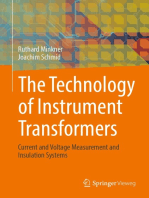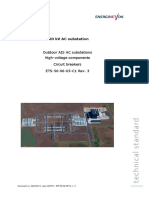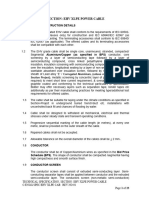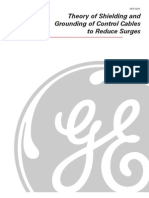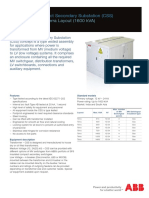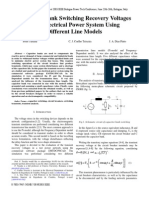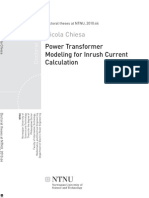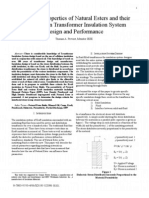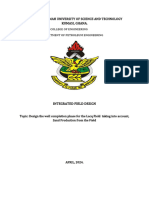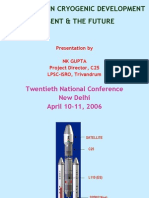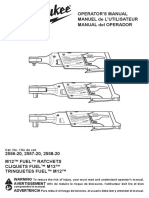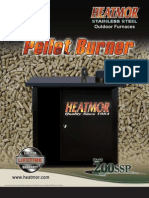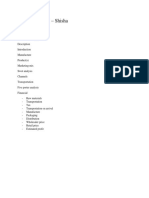Data Bulletin Transformer Key Features: Dry-Type, Cast-Resin, and Liquid-Filled Transformers Class 7300
Data Bulletin Transformer Key Features: Dry-Type, Cast-Resin, and Liquid-Filled Transformers Class 7300
Uploaded by
Dinesh SelvakumarCopyright:
Available Formats
Data Bulletin Transformer Key Features: Dry-Type, Cast-Resin, and Liquid-Filled Transformers Class 7300
Data Bulletin Transformer Key Features: Dry-Type, Cast-Resin, and Liquid-Filled Transformers Class 7300
Uploaded by
Dinesh SelvakumarOriginal Title
Copyright
Available Formats
Share this document
Did you find this document useful?
Is this content inappropriate?
Copyright:
Available Formats
Data Bulletin Transformer Key Features: Dry-Type, Cast-Resin, and Liquid-Filled Transformers Class 7300
Data Bulletin Transformer Key Features: Dry-Type, Cast-Resin, and Liquid-Filled Transformers Class 7300
Uploaded by
Dinesh SelvakumarCopyright:
Available Formats
Data Bulletin Transformer Key Features
Dry-Type, Cast-Resin, and Liquid-Filled Transformers Class 7300
Retain for future use.
7300DB0401 12/2004 Monroe, NC USA Replaces 7300PD9203, 02/1992
INTRODUCTION PRODUCT FEATURES AND BENEFITS
Table 1:
Product
Ventilated Dry-Type VacuumPressure Impregnation (VPI) Transformers 22513,000 kVA
This data bulletin contains key features about Square D/Schneider Electric dry-type, cast-resin, and liquid-filled transformers.
Dry-Type, Cast-Resin, and Liquid-Filled Transformers
Key Features
150 C Rise 220 C Insulation Optional 115 C or 80 C Rise 180 C Insulation Can be fan-cooled @ 33% overload (OL)
Benefits
Additional Information: See
Best Application for Use
General applications, where cost of power is a major concern High ambients or where cost of losses is important Environments where load varies In damp environments; where chemical fumes, high fault probability, and high impact loads exist Periods of no-loads and/or cold, damp environments Dusty and dirty environments Where cost of power is a major concern Where max reliability is important Where load varies greatly
Lowest first cost Temperature Winding Rise and Light weight Insulation Class and Nonflammable Overload capability and/or low watts Transformers on page 2 loss = low operating costs Handles peak load with less cost than larger units Max protection from the environment; max short-circuit strength No pre-drying before energizing Ease of cleaning coil Temperature Winding Rise and Insulation Class and Nonflammable Transformers on page 2 Solid Dielectric Insulation on page 2 Fan-Cooled Ratings on page 2 Fan-Cooled Ratings on page 2
Cast coil
Cast Epoxy on page 2
Power-Cast 80 C Rise Transformers 50013,000 kVA Solid dielectric Can be fan-cooled @ 33% (10005000) kVA 50% OL Basic Insulation Level (BIL) equivalent to liquid-filled transformers Oil coolant and dielectric Can be fan-cooled @ Oil-Filled 15% (2252500 kVA) or Substation 25% (250010,000 kVA) or 22520,000 kVA 33% above 10,000 kVA Higher BIL than dry-type transformers High fire point fluid coolant and dielectric High Fire Point Can be fan-cooled @ Liquid-Filled 15% (2252500 kVA) or 25% (250010,000 kVA) or Substation 22520,000 kVA 33% above 10,000 kVA Higher BIL than dry-type transformers Oil coolant and dielectric Oil-Filled, Pad-Mounted Pad-mounted Transformers Higher BIL than dry-type 7510,000 kVA transformers High fire point fluid coolant High Fire Point and dielectric Liquid-Filled, Pad-Mounted Pad-mounted Transformers Higher BIL than dry-type 7510,000 kVA transformers
Low watts loss Partial discharge tested Handles peak loads with less cost than larger units More protection from voltage surges inherent in the design Least expensive of liquid-filled transformers Handles moderate overloads with less cost than larger units Less vulnerable to voltage surges Less flammable than oil Handles moderate overloads with less cost than larger units Less vulnerable to voltage surges Least expensive Tamperproof construction and underground feeds Less vulnerable to voltage surges Less flammable than oil Tamperproof construction and underground feeds Less vulnerable to voltage surges
When used as a replacement (no need Transformer Basic Insulation Levels to rework the system design if used on page 3 to replace a liquid-filled transformer) Oil-Filled Transformers on page 2 Where first cost is a factor
Fan-Cooled Ratings on page 2
Where load varies moderately
Transformer Basic Insulation Levels Outdoor environments on page 3 Indoors without a vault, with some High Fire Point Fluids on page 3 restrictions Fan-Cooled Ratings on page 2 Where load varies moderately
Transformer Basic Insulation Levels Indoor or outdoor environments on page 3 Oil-Filled Transformers on page 2 Where first cost is a factor Where exposed to public access Pad-Mounted Transformers on page 3 (normally outdoors) Transformer Basic Insulation Levels Outdoor environments on page 3 Anywhere an oil fire hazard High Fire Point Fluids on page 3 is unacceptable Where exposed to public access Pad-Mounted Transformers on page 3 (normally outdoors) Transformer Basic Insulation Levels Indoor or outdoor environments on page 3
Transformer Key Features Product Features and Benefits
7300DB0401 12/2004
ADDITIONAL TRANSFORMER INFORMATION Temperature Winding Rise and Insulation Class
This section provides additional transformer information as outlined in Table 1 on page 1. Table 2 lists the full load temperature rise of each type transformer and the insulation class normally used for that temperature rise. Table 2: Temperature Winding Rise and Insulation Class
Temperature Winding Rise
80 C (Optional) Dry-Type (VPI) 115 C (Optional) 150 C (Normal) 80 C (Normal) Power-Cast II 100 C (Optional) 115 C (Optional) Liquid-Filled 55 C (Optional) 65 C (Normal) 120 C 185 C 220 C
Transformer Type
Insulation Class
Nonflammable Transformers
Both VPI dry-type and Power-Cast II transformers are considered by codes to be nonflammable. However, they will burn if subjected to a continual source of flame, such as being exposed to a structural fire of the building in which the transformer is installed. Table 3 lists the available fan cooled ratings of Square D transformers. Table 3: Fan-Cooled Ratings
Fan-Cooled Ratings
331/3% 331/3% 50% through through 750 kVA 10005000 kVA 25% through 250010,000 kVA 331/3% above 10,000 kVA
Fan-Cooled Ratings
Transformer Type
Dry-Type (VPI) Power-Cast Liquid-Filled
15% through 2000 kVA
331/3% above 10,000 kVA
Cast Epoxy
Cast epoxy provides the best protection from environment for the coil itself. It is non-hygroscopic (will not absorb water to a significant degree) and is not affected by common industrial chemicals and airborne pollutants. Solid dielectric insulation provides long-term freedom from thermal aging and slow degradation of the dielectric system. Once the system is in place and tested satisfactorily, there is less chance of embrittlement than with conventional transformers. Oil-filled transformers are less expensive than high fire point liquid-filled, RTemp-filled, or other fluid units. They are normally less expensive than dry-type (VPI) or cast transformers as well, on a first-cost basis.
Solid Dielectric Insulation
Oil-Filled Transformers
19922004 Schneider Electric All Rights Reserved
7300DB0401 12/2004
Transformer Key Features Quick Comparisons
Transformer Basic Insulation Levels
Table 4:
kV Class
1.2 2.5 5.0 7.2 8.66 15.0 25.0 34.5 46.0 69.0
Table 4 shows the basic insulation level (BIL) of the various transformer construction types.
Transformer Basic Insulation Levels
VPI Dry-Type
10 30 30 45 45 60 110 150
VPI Dry-Type
30 45 60 60 60 95 125
Distribution-Class Liquid-Filled
30 45 60 60 75 95 125 150
Power-Class Liquid-Filled
45 60 75 75 95 110 150 200 250 350
Power-Cast Transformers
10 45 60 60 75 95 125 150
Power-Cast Transformers
30 60 75 75 95 110 150 200
Represents optional available ratings
High Fire Point Fluids
High fire point fluids have a higher flash, fire, and auto-ignition points than oil and therefore, may be used inside buildings where oil is prohibited by codes. Refer to National Electrical Code (NEC), Article 450-23 through 450-26. The principal distinguishing feature of a pad-mounted enclosure is that it is tamper-resistant and completely barriers the transformer. This means it is impossible to reach any live part of the transformer (neither by poking a wire through an opening or hole nor by removing any nuts or bolts from outside the enclosure). Because of this construction, it is permissible to install a pad-mounted transformer where the general public has actual physical access to the outside of the enclosure. Refer to Table 5 below and Tables 6 and 7 on page 4 for quick comparisons of transformer types. Refer to Table 5 for transformer environments. Transformer types are listed in the order of first choice, then next preferred choice. Table 5:
Environment
Pad-Mounted Transformers
QUICK COMPARISONS Environments
Transformer Environments and Types
Transformer Type
Pad-Mounted Liquid-Filled Power-Cast VPI
Outdoor
Contaminated Industrial
Power-Cast Liquid-Filled (Oil or High Fire Point) Liquid Power-Cast VPI
High Humidity
Indoor (Clean)
High Fire Point Power-Cast
19922004 Schneider Electric All Rights Reserved
Transformer Key Features Data Bulletin
7300DB0401 12/2004
Cooling Characteristics
Refer to Table 6 for the cooling characteristics of transformers. Table 6: Transformer Types and Cooling Characteristics
Fan Cooled
33% or 50% 33% 33% 33% 15%, 25%, or 33% 15%, 25%, or 33%
Transformer Type and Temperature
80 C Power-Cast 80 C VPI Watchdog 115 C VPI Watchdog 150 C VPI 55 C Liquid-Filled Substation 65 C Liquid-Filled Substation 55 C Pad-Mounted 65 C Pad-Mounted
Self Cooled
15% 30% 15% 12% 12%
Weight (15 kV Class)
Refer to Table 7 for transformer types and weights. Weights are approximate and depend on many factors including primary and secondary voltages, BIL, %IZ, as well as kVA and temperature rise. High fire point liquid-filled substations weigh approximately 5% more than oil-filled substations. Table 7:
kVA 225 500 1000 2000 3000 5000
Transformer Types and Weights
150 C Dry 6000 6250 7500 10,200 17,000 25,000 80 C Dry 6000 6530 9200 14,850 20,850 30,000 80 C Power-Cast 6400 8000 11,000 17,000 25,000 37,000 65 C Oil Substation 4800 5400 7300 11,600 19,000 30,000
SPECIAL CONSIDERATIONS
Check code requirements for oil- or high fire point liquid-filled units used indoors. Refer to NEC Article 450. In some circumstances, curbing and sprinkler systems are required.
Schneider Electric USA 1809 Airport Road Monroe, NC 28111 USA 1-888-SquareD (1-888-778-2733) www.us.SquareD.com
Electrical equipment should be installed, operated, serviced, and maintained only by qualified personnel. No responsibility is assumed by Schneider Electric for any consequences arising out of the use of this material. 19922004 Schneider Electric All Rights Reserved
You might also like
- DNV-SE-0190 Project Certification of Wind Power PlantsDocument181 pagesDNV-SE-0190 Project Certification of Wind Power PlantsOrlando ArayaNo ratings yet
- TG Net SST 200Document14 pagesTG Net SST 200NiemNo ratings yet
- The Technology of Instrument Transformers: Current and Voltage Measurement and Insulation SystemsFrom EverandThe Technology of Instrument Transformers: Current and Voltage Measurement and Insulation SystemsNo ratings yet
- Electrical Manual of GSK980TDbDocument18 pagesElectrical Manual of GSK980TDbjavier medina100% (1)
- Standardized Survey of Transformer Reliability: On Behalf of CIGRE WG A2.37Document5 pagesStandardized Survey of Transformer Reliability: On Behalf of CIGRE WG A2.37Денис ЛяпуновNo ratings yet
- Trans Line LADocument8 pagesTrans Line LAsantoshkumarNo ratings yet
- 1376 Rekaguide To Usefor52 145kvDocument26 pages1376 Rekaguide To Usefor52 145kvparthaNo ratings yet
- Cable With Standing CurvesDocument63 pagesCable With Standing CurvesRatheesh R NairNo ratings yet
- Characteristics of Different Power Systems Neutral Grounding Techniques: Fact & FictionDocument12 pagesCharacteristics of Different Power Systems Neutral Grounding Techniques: Fact & FictionOcktafriandi HendraNo ratings yet
- Fault Current Contribution From VSC-based WindTurbines To The GridDocument8 pagesFault Current Contribution From VSC-based WindTurbines To The GridhassanNo ratings yet
- Sheath Voltage CalculationsDocument2 pagesSheath Voltage CalculationssiddharthangandhiNo ratings yet
- FprEN 50216-12 2010Document13 pagesFprEN 50216-12 2010Mahmoud ShaheenNo ratings yet
- Specifications Pakistan Review Report 23-08Document11 pagesSpecifications Pakistan Review Report 23-08Adil IftikharNo ratings yet
- 12 - 308 - 1998 Variable Mvar Output Shunt Reactors PDFDocument12 pages12 - 308 - 1998 Variable Mvar Output Shunt Reactors PDFJorge Pinto RochaNo ratings yet
- Compact Power Transformers For Substation in Urban Areas Using Hybrid Insulation SystemDocument8 pagesCompact Power Transformers For Substation in Urban Areas Using Hybrid Insulation SystemR0B0T2013No ratings yet
- Cable CapacitanceDocument7 pagesCable CapacitanceSankara Rao BonalaNo ratings yet
- Gas Insulated Substation (Gis) Vs Conventional Outdoor Substation (Ais)Document12 pagesGas Insulated Substation (Gis) Vs Conventional Outdoor Substation (Ais)Sa'dun ArifNo ratings yet
- ETS-50!06!05-C1 High-Voltage Components - Circuit Breaker 400 KVDocument10 pagesETS-50!06!05-C1 High-Voltage Components - Circuit Breaker 400 KVraghavendran raghuNo ratings yet
- 23.0 EHV XLPE Cable Rev01Document23 pages23.0 EHV XLPE Cable Rev01Ashish bhattNo ratings yet
- On-Line Dynamic Cable Rating For Underground Cables Based On DTS and FEM (Liang2008)Document10 pagesOn-Line Dynamic Cable Rating For Underground Cables Based On DTS and FEM (Liang2008)daegerteNo ratings yet
- AusNet Services - AMS 10-60 - Earth Grids - Non Confidential - October 2015Document12 pagesAusNet Services - AMS 10-60 - Earth Grids - Non Confidential - October 2015andyhilbertNo ratings yet
- CSP SystemDocument23 pagesCSP Systemvinay kumarNo ratings yet
- Inverter Modelling: 1 PurposeDocument23 pagesInverter Modelling: 1 PurposeLeonardo LeonNo ratings yet
- Ger 3205Document8 pagesGer 3205ohobohoNo ratings yet
- ABB UniPack Datasheet TERRA 1600kVA WEBDocument2 pagesABB UniPack Datasheet TERRA 1600kVA WEBprashanth chandrashekarNo ratings yet
- Calculation and Analysis of Transformer Inrush Current Based On Parameters of Transformer and Operating ConditionsDocument4 pagesCalculation and Analysis of Transformer Inrush Current Based On Parameters of Transformer and Operating ConditionshnphuocNo ratings yet
- EDS-50-05 132-400 KV AC Stations - Standard Reactor SizesDocument5 pagesEDS-50-05 132-400 KV AC Stations - Standard Reactor Sizesraghavendran raghuNo ratings yet
- Application Guide - Primary Neutral EarthingDocument17 pagesApplication Guide - Primary Neutral EarthingChandra Pal100% (1)
- Touch and Step Potentials, Limits and ApplicationDocument17 pagesTouch and Step Potentials, Limits and ApplicationAnoop PrajapatiNo ratings yet
- Partial Discharge 1 PDFDocument8 pagesPartial Discharge 1 PDFsamsungloverNo ratings yet
- Specification NGRDocument7 pagesSpecification NGRPrasenjit MaityNo ratings yet
- Prominent Features and Benefits Hyundai Power TransformerDocument2 pagesProminent Features and Benefits Hyundai Power TransformerjuliancansenNo ratings yet
- Netschema Transportnet 22NLT03 by HoogspanningsNetDocument1 pageNetschema Transportnet 22NLT03 by HoogspanningsNetHarry NakNo ratings yet
- PEXLIM P-Y - Section of Surge Arrester Buyers Guide - Edition 11 2014-05 - English - 1HSM 9543 12-00enDocument8 pagesPEXLIM P-Y - Section of Surge Arrester Buyers Guide - Edition 11 2014-05 - English - 1HSM 9543 12-00enMochamad Ridwan100% (1)
- Snubber DesignDocument4 pagesSnubber DesignSaffatt Al MansoorNo ratings yet
- REK28E Oil Immersed Shunt Reactors For 10-400 KV System Voltage 3rd Version (ENG) 4.0 PDFDocument29 pagesREK28E Oil Immersed Shunt Reactors For 10-400 KV System Voltage 3rd Version (ENG) 4.0 PDFSofyanNo ratings yet
- Current Transformer - Electrical Notes & ArticlesDocument35 pagesCurrent Transformer - Electrical Notes & ArticlesBlake100% (1)
- Estimating Moisture in Power Transformers: Mohammad Tariq, MeggerDocument9 pagesEstimating Moisture in Power Transformers: Mohammad Tariq, Meggerpoeta_oscuroNo ratings yet
- Over Load Protection For TransformerDocument45 pagesOver Load Protection For Transformerupender_kalwaNo ratings yet
- Trformer RegulationDocument4 pagesTrformer RegulationKrishnanNo ratings yet
- Standard Inspection and Test Plan ITP No: 721 Control Panel, Console, Desks and Marshalling Cabinet InstallationDocument1 pageStandard Inspection and Test Plan ITP No: 721 Control Panel, Console, Desks and Marshalling Cabinet InstallationUtku Can KılıçNo ratings yet
- Neutral Grounding Professor Ahdab ElmorshedyDocument35 pagesNeutral Grounding Professor Ahdab ElmorshedyRama PrasadNo ratings yet
- 800kVGIS Spec Rev1Document51 pages800kVGIS Spec Rev1JayadevDamodaranNo ratings yet
- BTB Earthing Transformers IntDocument2 pagesBTB Earthing Transformers IntSharath KotaNo ratings yet
- Effect of Grading Ring On Voltage Distribution of ArrestorsDocument7 pagesEffect of Grading Ring On Voltage Distribution of ArrestorsTravis WoodNo ratings yet
- Transformer SpecificationDocument4 pagesTransformer SpecificationMhd MouffakNo ratings yet
- Trainning Report of VoltapmDocument21 pagesTrainning Report of VoltapmRavi PatelNo ratings yet
- Recovery of Switching CapacitorDocument4 pagesRecovery of Switching CapacitorYudo Heru PribadiNo ratings yet
- Upf MythDocument3 pagesUpf MythgurbachansainiNo ratings yet
- RalphChristie How Calculate Zigzag TransformerDocument1 pageRalphChristie How Calculate Zigzag TransformermohammadkassarNo ratings yet
- Cable Short Circuit RatingsDocument2 pagesCable Short Circuit Ratingstees220510No ratings yet
- Cigré2016 Experiencesandinnovationsinpowertransformershort Circuitcurrentwithstandtesting A2 304Document11 pagesCigré2016 Experiencesandinnovationsinpowertransformershort Circuitcurrentwithstandtesting A2 304cisnatelNo ratings yet
- CoreTec 4 - Transformer Monitoring PlatformDocument2 pagesCoreTec 4 - Transformer Monitoring PlatformJaime Vicuña CubillosNo ratings yet
- Breaker o Co Operation & PIRDocument2 pagesBreaker o Co Operation & PIRabhi_akNo ratings yet
- 1000 KV Power TransformerDocument4 pages1000 KV Power TransformeralpcruzNo ratings yet
- Transformer Design and Application Considerations For Nonsinusoidal Load Currents PDFDocument13 pagesTransformer Design and Application Considerations For Nonsinusoidal Load Currents PDFRajuNo ratings yet
- VSC-FACTS-HVDC: Analysis, Modelling and Simulation in Power GridsFrom EverandVSC-FACTS-HVDC: Analysis, Modelling and Simulation in Power GridsNo ratings yet
- Grid-Integrated and Standalone Photovoltaic Distributed Generation Systems: Analysis, Design, and ControlFrom EverandGrid-Integrated and Standalone Photovoltaic Distributed Generation Systems: Analysis, Design, and ControlNo ratings yet
- Current Interruption Transients CalculationFrom EverandCurrent Interruption Transients CalculationRating: 4 out of 5 stars4/5 (1)
- Today World of India PDFDocument14 pagesToday World of India PDFDinesh SelvakumarNo ratings yet
- A Guide To Megger Insulation For Testing PruposesDocument40 pagesA Guide To Megger Insulation For Testing PruposesDinesh Selvakumar100% (1)
- Development of India'S First Coupling Transformer For Statcom ApplicationsDocument20 pagesDevelopment of India'S First Coupling Transformer For Statcom ApplicationsDinesh SelvakumarNo ratings yet
- Majestic Panoramic Sunroof Cutting Edge 2.0L Diesel Engine Mated To An Advanced 6 - Speed Automatic TransmissionDocument2 pagesMajestic Panoramic Sunroof Cutting Edge 2.0L Diesel Engine Mated To An Advanced 6 - Speed Automatic TransmissionDinesh SelvakumarNo ratings yet
- Is 6600 1972 PDFDocument33 pagesIs 6600 1972 PDFDinesh SelvakumarNo ratings yet
- ALWAYE BrochureDocument4 pagesALWAYE BrochureDinesh SelvakumarNo ratings yet
- InrushDocument226 pagesInrushDinesh Selvakumar100% (1)
- On Load Tap ChangerDocument8 pagesOn Load Tap ChangerDinesh SelvakumarNo ratings yet
- 17 Dielectric Propertiesand Insulation System DesignDocument5 pages17 Dielectric Propertiesand Insulation System DesignDinesh Selvakumar100% (1)
- Zero SequenceDocument3 pagesZero SequenceDinesh SelvakumarNo ratings yet
- Crankshaft Failure Due To Fatigue-ADocument7 pagesCrankshaft Failure Due To Fatigue-Aaschutsehay0123No ratings yet
- Lacq Field FinalDocument72 pagesLacq Field FinalAnkamah EdmondNo ratings yet
- Unit 6 & 7 Dimension of BakingDocument9 pagesUnit 6 & 7 Dimension of Bakingkeyrie88100% (1)
- The Thermodynamic Properties of Platinum: by J. W. ArblasterDocument9 pagesThe Thermodynamic Properties of Platinum: by J. W. ArblasterEmmanuel PlazaNo ratings yet
- Challenges in Cryogenic Development Present & The Future: Twentieth National Conference New Delhi April 10-11, 2006Document36 pagesChallenges in Cryogenic Development Present & The Future: Twentieth National Conference New Delhi April 10-11, 2006Gopala KrishnaNo ratings yet
- Custom Pulse TransformersDocument6 pagesCustom Pulse Transformersfemco.ftmNo ratings yet
- Vihtavuori Reloading Guide Ed9 Updt July2011 EngDocument37 pagesVihtavuori Reloading Guide Ed9 Updt July2011 EngSamo KrznaričNo ratings yet
- Untitled SpreadsheetDocument23 pagesUntitled SpreadsheetFalgon IslamNo ratings yet
- Varispeed g7Document499 pagesVarispeed g7Victor YosafatNo ratings yet
- SST 111 Steam Turbine eDocument4 pagesSST 111 Steam Turbine eVlad Alexeiciuc100% (1)
- Table of Specification: 1. Chemical BondingDocument4 pagesTable of Specification: 1. Chemical BondingMantikar IsmaelNo ratings yet
- Operator'S Manual Manuel de L'Utilisateur Manual Del OperadorDocument12 pagesOperator'S Manual Manuel de L'Utilisateur Manual Del OperadorЗеновійNo ratings yet
- H - 1370 KJ Mol: Questions 4, 5 and 6 Refer To The Following InformationDocument9 pagesH - 1370 KJ Mol: Questions 4, 5 and 6 Refer To The Following Informationinder191No ratings yet
- Ap BessDocument93 pagesAp BessSudesh AggarwalNo ratings yet
- Ahmedabad PDFDocument16 pagesAhmedabad PDFDhaval DadhaniaNo ratings yet
- Certificate: Caterpillar Energy Solutions GMBHDocument2 pagesCertificate: Caterpillar Energy Solutions GMBHMuhammad Yasir100% (1)
- Gas Insulated SwitchgearDocument33 pagesGas Insulated SwitchgearsudhirguduruNo ratings yet
- Grinding Errors and Possible SolutionsDocument6 pagesGrinding Errors and Possible SolutionsPinak ThankiNo ratings yet
- Nexus Deepwater EngineeringDocument18 pagesNexus Deepwater EngineeringHuy LâmNo ratings yet
- Heatmor Pellet BurnerDocument12 pagesHeatmor Pellet BurnerHelicon1100% (1)
- Leser API 520 LiquidDocument6 pagesLeser API 520 LiquidWidyaNo ratings yet
- Coconut Shell CharcoalDocument11 pagesCoconut Shell CharcoalErfan TanhaeiNo ratings yet
- SF - An Excellent Insulating and Quenching Gas: Substantial Properties at A GlanceDocument16 pagesSF - An Excellent Insulating and Quenching Gas: Substantial Properties at A GlancedennyyusufNo ratings yet
- EE8703 Renewable Energy Systems MCQ PadeepzDocument9 pagesEE8703 Renewable Energy Systems MCQ Padeepzpriya dharshiniNo ratings yet
- IC Joshi Aviation Met Total QDocument89 pagesIC Joshi Aviation Met Total Qsakshee gojreNo ratings yet
- EUBP BP Mechanical RecyclingDocument7 pagesEUBP BP Mechanical RecyclingDonato GalloNo ratings yet
- Implementation and Evaluation Maximum Power Point Tracking (MPPT) Based On Adaptive Neuro Fuzzy Inference Systems For Photovoltaıc PV SystemDocument121 pagesImplementation and Evaluation Maximum Power Point Tracking (MPPT) Based On Adaptive Neuro Fuzzy Inference Systems For Photovoltaıc PV Systematılay demirezerNo ratings yet
- Waste Not Want Not SummaryDocument17 pagesWaste Not Want Not SummaryYoucef FBNo ratings yet
- Blue Star 185Document4 pagesBlue Star 185Amando FuentesNo ratings yet


